



Issue 10 at new CDC reducing falls Enhanced Care Team First look How we are Introducing new Page 12 Page 4 Page 7 IMPACT Partnering Ambitious Caring Trusted September 2023
Research, innovation and improvement is supporting our journey towards Getting to Good, and delivering our vision to provide excellent care for the communities we serve.
Innovation doesn’t need to be big or expensive, sometimes the most powerful changes which can benefit patients can be small. We recently held our Research, Innovation and Improvement Week, which was a chance to share the fantastic work being done across our organisation to drive continuous improvement and embed research and innovation into clinical practice.
I want to thank everyone involved in this really important, and exciting work. Through Impact, we will continue to share fantastic examples of the difference you are making for our communities and patients through research and embracing innovation.
I am incredibly proud of the work you are doing together as we strive to create an organisation in which we are all proud to work and where care is high quality, safe and compassionate.
Improvement runs through our Trust Strategy, which sets out our aims for the coming years and how we are going to achieve them.
Having a strategy is really
FOREWORD
Louise Barnett Chief Executive

Dear colleague,
Welcome to this month’s edition of Impact, which I hope you enjoy reading as much as I enjoy hearing from you about all your amazing achievements.
important. This guides us, helping us to plan for the future, to ensure we are always doing our best for the people we care for and for our valued colleagues.
Our strategy has been shaped by you. We have listened to colleagues who work in our Trust, as well as our partners and the patients who use our services, to understand what matters most and what we should focus on. These have become the goals which will drive us forward.
Please do find some time to read our strategy here.
Improving the quality of care we provide is a key area of focus and will help us improve our Care Quality Commission (CQC) rating.
You can read about some of the improvement work we are doing, with your support, to achieve this. This includes improving our urgent and emergency care pathways so our patients are getting the right care in the right place. Also, you can read how our amazing colleagues on Ward 10 have achieved some incredible results reducing patient length of stay and referring into the Virtual Ward on page 10
This month saw Falls Awareness Week. Our teams are doing some fantastic work to support and empower our vulnerable patients and reduce the amount of inpatient falls. This is one of
our nine quality priorities in our Operational Plan, and you can read more on page 4
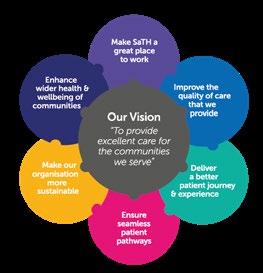
You may be aware that it has been some time since our last unannounced inspection by the CQC. While we remain rated as inadequate overall following the inspection in summer 2021, we were pleased they acknowledged that we had made improvements in many areas for our patients. I know that meant a lot to so many of you.
We are due an inspection soon, although we will not be told when this will be. I really want to encourage you to be proud of everything you do when the inspectors visit. Be honest about the challenges we face and share the positive changes you have made or are making and how the work you are doing in your teams will improve our patient’s experience and care in our services.
There is a fantastic FAQs on our intranet here to help support you, and if you would like further support contact our CQC team via sath.cqcinspection@nhs. net
Thank you.
Impact Magazine - Issue 10 2
MESSAGE
Mary Aubrey Getting to Good Programme Director
Dear colleague,
We are continuing to make good progress on our journey of continuous improvement which is fantastic for both patients and colleagues.
You should all feel incredibly proud of the transformational work that is being done to improve the quality of care for our patients and the working environment for everyone who works in our organisation.
Our Getting to Good programme, supported by our fantastic colleagues in the Performance Management Office (PMO), continues to drive forward our key projects to ensure they are on track for successful completion.

We are currently in phase three of the programme, working at pace to deliver key milestones to reach our end goal.
This month we have a targeted focus on the following projects:
• Recruitment and Retention
• Cancer performance
• Urgent and Emergency Care
• Expansion of the Medical Examiners’ Office
• Risk Management
You can read more about how we are improving recruitment and retention and our cancer performance, as well as growing our Medical Examiners Service in the next edition of Impact.
With the CQC due to make an unannounced inspection of the services provided by our hospitals, it is so important that you share with them the improvements you have been making and how they are making a difference to the care that you are
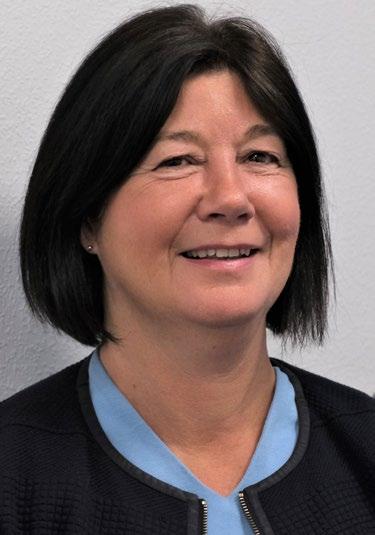
providing. Please be honest and prepared, and most of all be proud.
Our Getting to Good posters should now be with your wards and departments. Please do use these to help you prepare, and talk within your teams about your improvements and your successes, and also about what your next steps will be and if you need support.
Our colleagues in the Improvement Hub can support you if you have an improvement idea and need help to get it off the ground.
There are many ways that they can help with this, so please do contact them via sath. improvementhub@nhs.net.
Thank you.
Impact Magazine - Issue 10 3
IMPROVING QUALITY OF CARE
Ensuring that our patients receive high quality care in a safe environment is one of our key priorities.
We know that falls are the most common patient safety incident in healthcare, particularly affecting those over the age of 65, so we are working hard to reduce the number of inpatient falls in our hospitals. This work is so important, it is one of our nine quality priorities in our Operational Plan.
We are investing in dedicated falls awareness and prevention training for our teams. We are also empowering patients by providing them with the right knowledge and support. This can involve encouraging patients to be active to improve their strength and balance.
A new falls training programme for colleagues is being implemented by Leeanne Morgan, Falls Prevention Practitioner. An Enhanced Care Supervision Team which provides 1:1 patient supervision to those most at risk, is also in place.
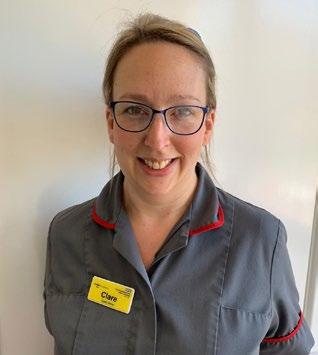
We are already seeing positive outcomes with 15-30 fewer falls
per month since last January.
Leeanne said: “Preventing falls in hospital is so important in improving patient safety, reducing deconditioning and supporting a shorter length of hospital stay. We also know the pain and distress that can be caused as a result of injury from falls. Some falls can have a huge, life-changing impact on patients.
“A risk assessment of all the potential causes of falls is an essential part of a patient’s care. This assessment then helps staff to formulate a person-centred management plan, which shapes a patient’s care and provides staff with guidance on all they can do to prevent their patients from falling.
“Such interventions can include visual cues of risk for colleagues, patient information leaflets, considering the location of the patient within the ward as well as the type of bed they are given and their supervision needs.
“We offer supported patient activity and reconditioning as part of any assessment and this is key to helping patients to improve their strength, balance and resilience.
“This can have such a positive impact on reducing their risk of falls and also influence their outlook on life.”

Turn to the next page to see how we are reducing falls.
“Our teams have worked exceptionally hard to reduce the number of inpatient falls through a number of initiatives. It is fantastic that they are embracing the programme and the results are so positive with our hospitals seeing fewer patient falls since January. It makes such a difference to the care of our patients and enables our colleagues to have the right training to help them feel empowered.”
Clare Walsgrove, Quality Matron
OUR GETTING TO GOOD IMPROVEMENT JOURNEY
Caring Impact Magazine - Issue 10 4


OUR GETTING TO GOOD IMPROVEMENT JOURNEY Caring Impact Magazine - Issue 10 5
HOW
WE ARE
REDUCING INPATIENT FALLS
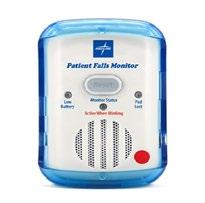
Falls alarm rollout coming soon to RSH
The alarm is a movement detection system to be used in the care of our most vulnerable patients who require a high-low bed. This can be used either on the bed or on a chair and the alarm will sound if a patient attempts to stand. This gives colleagues an opportunity to reach the patient before they fall.
Recent trial
Falls Awareness Week (18-22 September)
A full week of activities took place to encourage patients to get up and moving. Included in the activities were various competitions and training sessions to raise colleague awareness of falls risks.
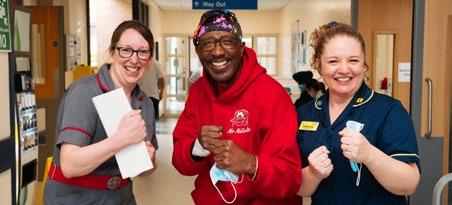
Coming soon – trustwide rollout of neurological observation training
All Registered Nurses, Nursing Associates, Advanced Clinical Practitioners and Allied Health Professionals to receive training to improve knowledge of head injury guidance, monitoring of Glasgow coma scoring and Trust protocol to improve post-fall care for our patients.

of yellow
blankets in ED at PRH
Yellow blankets provide a big visual cue for staff, that a patient may be at risk of falls. This increases staff awareness and flags the need for further interventions to mitigate the risk.

Reconditioning Games
Hospitals were encouraged to reduce deconditioning by increasing and improving patient activity during their hospital stay. This was by providing both physical activity and cognitive stimulation.
Our organisation finished first regionally and third nationally, with medals awarded for colleagues’ work on the Games.
Phase 2 of the games has now started, please support this important work.
18 - 24 September 2023 OUR GETTING TO GOOD IMPROVEMENT JOURNEY Caring Impact Magazine - Issue 10 6
ENHANCED CARE TEAM
We have a fantastic team who are providing a new one-to-one care service for our patients – and we are growing this team even further.
Our aim is to enhance the care provided to patients to prevent deconditioning (decreased strength, endurance and balance).
Samantha Matthews, Clinical Lead Enhanced Care Team, manages a team of 14 Enhanced Care Support Workers (ECSW) who are already working with patients on our wards.
Another 21 colleagues will be joining the team soon, working across sites and in shifts to provide increased resilience. They will provide support for patients with high levels of care and supervision needs, such as those living with dementia or mental health challenges or experiencing
substance withdrawal or delirium.
The team encourages patients to engage in cognitive and physical activities to reduce the risk of deconditioning and enhance their experience, as well monitoring and managing any behaviour changes. This level of supervision is undertaken for the shortest period of time, where appropriate, and is determined through nursing observation and the completion of a risk assessment to initiate this support service.
Samantha said: “It is exciting to be part of this developing team and service. It is fantastic that the Trust has invested in this service and recognises that some patients need dedicated 1:1 enhanced care and supervision during their hospital journey.
“Together with our new dedicated team, and trust-wide
colleagues, we are motivated to develop and shape this service to ensure we are providing the best possible care, support and supervision for our patients.”
The team provides:
• Personal care
• Basic observations
• Behaviour/conduct monitoring
• De-escalation management and intervention, whether planned or spontaneous
• Chair-based exercises and physical activity planning, for example dance, movement and balloon tennis

• Cognitive engagement through puzzles, games, art, music or song.
The team also complete a Patient Activity Support and Supervision (PASS) document to support nurses with their care plans and risk assessments. They also liaise with and support therapists to provide an integrated service.
OUR GETTING TO GOOD IMPROVEMENT JOURNEY Caring Impact Magazine - Issue 10 7
CARE IN THE RIGHT PLACE
Ensuring that our patients are receiving the care they need in the right place at the right time is a huge priority on our improvement journey.
We are seeing high demand for our urgent and emergency care services, which along with challenges in discharging patients who are ready to leave our care, is resulting in long waits for patients.
These issues cannot be managed by our organisation alone and so we are working together with our health and care partners on implementing a system-wide urgent and emergency care improvement programme.
The aim of the programme is to ensure optimum flow into and out of our hospitals so our patients are not facing long waits to access a hospital bed, or long delays leaving hospital when they no longer need our care.
This will improve patient outcomes and the overall hospital experience for patients and their families. It ensures patients will be in the right place for their care. It will also help to reduce overcrowding and delays in our Emergency Departments for those arriving at the front doors, either by ambulance or by self-presenting. This in turn reduces the need for patients to wait in corridors for a hospital bed, and the use of escalation beds (beds reserved for emergencies).
Alongside some pre-hospital workstreams that our system partners are leading, there are currently eight workstreams within the SaTH programme focusing on improving discharge, flow, pathways and ward processes.
To date, we have seen improvements delivered
through:
• A reduction in 14+ and 21+ day length of stay, by case managing long stay patients and undertaking weekly reviews with our partners
• The development and implementation of a Discharge Management Tool to track every patient and ensure every patient has a care plan
• Changing the way our discharge lounge works, starting earlier in the day and developing a Pull “H for Home” model to pull patients identified as a definite discharge early in the day
• Standardising ward processes to support more consistent board rounds and improve next day planning
Karen Evans, Deputy Chief Operating Officer, said:
“This is a system-wide programme which will help us to put in place sustainable improvements to improve the patient journey through our hospitals.
“New standardised ward processes have also been put in place to enable patients to be discharged earlier in the day, when they are expected to be ready to leave our hospitals. This is helping to reduce length of stay for our patients and to create much-needed bed capacity to support patients who are waiting in our ED departments for a bed.
“We have also been developing direct access pathways, as well as focusing on improving the number of patients utilising the discharge loungesimportantly before 12 noon. We are making good progress, but we recognise there is still a long way to go.”
“An incredible amount of work has already been done by colleagues, including the creation of the new Acute Medical Floor at Royal Shrewsbury Hospital. This is already helping to reduce the number of patients in our Emergency Departments, including through direct admissions.”
Karen Evans, Deputy Chief Operating Officer
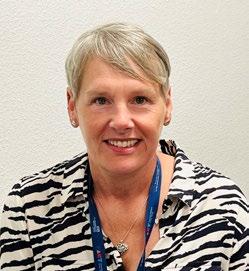
OUR GETTING TO GOOD IMPROVEMENT JOURNEY
Ambitious
Impact Magazine - Issue 10 8
Over the next few months the programme will focus on:
• Development of a frailty assessment area to reduce the length of stay in the EDs for our older population
• Increased utilisation of the Virtual Ward – a service provided by our community partners that enables patients with sub-acute needs to be supported and monitored in their own home by a highly skilled and experienced clinical team. Turn to the next page for more.

• Further consolidation of the ward processes
work across all wards
• Roll out of criteria-led discharge across medical and surgical wards
• Implementation of Outpatient Parenteral Antimicrobial Therapy (OPAT) service to enable patients to receive antibiotic therapy at home or as an outpatient - look out for more information on this in the next edition of Impact
• Case management of patients over 50 days length of stay, to ensure patients don’t stay in an acute hospital bed for longer than they need to
OUR GETTING TO GOOD IMPROVEMENT JOURNEY Ambitious
Impact Magazine - Issue 10 9
REDUCING LENGTH OF STAY

Colleagues on Ward 10 at Princess Royal Hospital have done a huge amount of work to improve the length of stay for their patients – halving the average number of days spent in hospital.

Colleagues, along with patient journey facilitators and physiotherapists, have worked together to review processes and put in place new ways of working, as well as regularly refer to the virtual ward. It is a significant achievement for the ward which cares for patients who are frail and have complex needs.
Despite challenges, including a COVID-19 outbreak on the ward and key staff changes, it has started to make a real difference for patients and their families.
Gary Francis is Ward 10’s Ward Manager and said: “Our patients are frail and complex, so we have a lot of patients living with dementia and with comorbidities. Our aim is to support them to leave hospital as quickly as possible, as we know this is better for them and reduces their risk of hospital acquired infection.
“We wanted to show that just because a patient is frail or has complex needs, they do not have to have long stays in hospital. When we first started
on this journey in January, our average length of stay was around 12 days. We reviewed our processes and managed, within the space of about 2-3 weeks, to reduce our average length of stay to just over 6 days.
“We managed to continue this but a series of challenges, including a covid outbreak and the loss of two key programme drivers, saw our length of stay go back up to around 11 days.
“Since April, we have had a new patient journey facilitator and we had a fresh look at our processes again. With everyone’s support, we have now managed to get our average length of stay to around 7 days. We would like to see that reduced more, but there are things that we can’t control like care packages and when they are available, so there is still work to do.
“We are also working with the front door team to see if we can pilot a pathway that brings patients straight up from ED to us. That would support continuity of care and helps us work towards a planned patient discharge. This would not have worked without the buy-in from everyone involved. It has really been a whole team effort and I am really proud of what we are achieving for our patients.”
OUR GETTING TO GOOD IMPROVEMENT JOURNEY Ambitious Impact Magazine - Issue 10 10
HOSPITAL AT HOME
We are working with our health partners to support our communities to get the right care in the right place at the right time. Not only does this improve outcomes, it also provides a better care experience.
Shropshire Community Health Trust has in place a virtual ward programme which our clinicians can refer appropriate patients into as an alternative to admission into our hospitals.
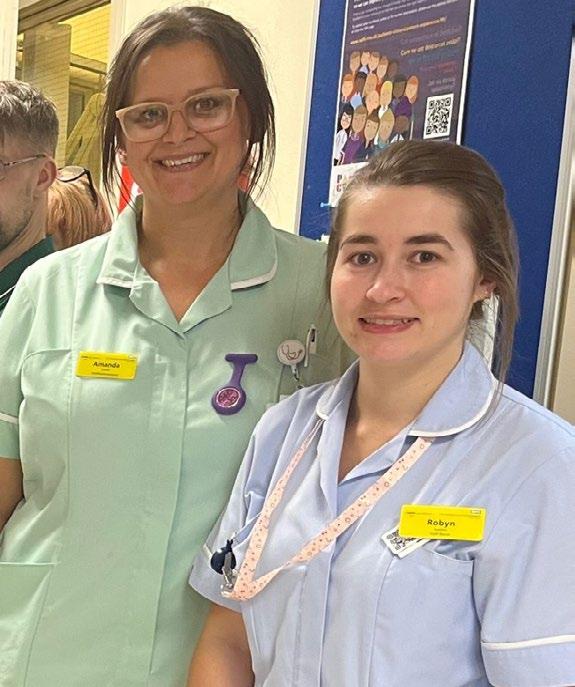
The virtual ward allows patients to get hospital-level care at home safely and in familiar surroundings, helping speed up their recovery while freeing up hospital beds for patients that need them most.
Multiple clinical pathways have been developed to onboard patients, including the frailty pathways for those aged 65 and over – with work ongoing to grow this further, and develop more and more pathways.
Our communities are already benefiting from this really important service which can be life-changing for some. You can find out about the difference it is making in this short video here
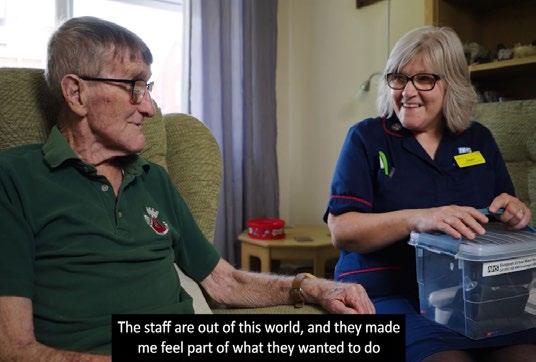
Currently there is support in place to manage 150
patients a day. However, there is a shared ambition to provide care and support for up to 250 patients a day by December to further support our patients and increase our resilience as we head into winter.
Just as in hospital, people on a virtual ward are cared for by a multidisciplinary team, including medics, pharmacy, nursing and AHPs, which provides a range of tests and treatments. This could include blood tests, prescribing medication or administering fluids through an intravenous drip.
Patients are reviewed daily by a clinical team and the ‘ward round’ may involve a home visit or take place through video technology.
Hassan Paraiso, Deputy Medical Director, said: “Referring patients to a virtual ward involves careful selection.
“That criteria can include chronic illness management for patients with conditions such as diabetes, hypertension or heart failure, and patients in need of a palliative care service to enhance their comfort and quality of life. The virtual ward can also support patients who prefer their care in the community.
“It is an alternative to a traditional ward, but patients are still receiving the care they would expect to receive on a ward.”
He added: “It is absolutely fantastic to hear how the virtual ward is making a life changing difference to some, and our focus remains on fully supporting this important service.”
OUR GETTING TO GOOD IMPROVEMENT JOURNEY Ambitious Impact Magazine - Issue 10 11
CARE CLOSER TO HOME
A key priority of providing access to care closer to home for our patients was realised this month. The opening of the county’s first Community Diagnostic Centre will help support our ambition to provide care closer to home for our patients.
The new four storey facility, located in Telford, will boost diagnostic capacity across Shropshire and Telford and Wrekin by almost a third and is almost complete. The first patients were recieved on Monday 2 October.

It will provide quicker and more convenient access to important tests for conditions such as cancer, heart and lung disease –without patients having to come into hospital.
This is a fantastic new facility for
patients, with services within the centre provided by teams from our organisation – including CT and MRI scans, blood tests and x-rays.
Karla Jennings-Preece, Project Lead and Operational Manager for the CDC, said: “Faster diagnostics is key to diagnosing a range of conditions, including cancer, as early as possible.
“The centre will see elective diagnostic tests delivered away from the acute hospital sites and separately from urgent diagnostic
scans.
“This will reduce waiting times for non-urgent tests and reduce the risk of cancellation. This is an exciting development which will improve clinical outcomes and patient experience.
“Locating the centre in the community means patients can access services more easily, which is fantastic for them and it will also help reduce pressure on our acute hospitals.”
Ambitious OUR GETTING TO GOOD IMPROVEMENT JOURNEY
Impact Magazine - Issue 10 12
When fully operational, the CDC will offer a range of services including CT, ultrasound, x-ray, MRI, ECG, echocardiograms, blood tests, lung functioning tests and basic sleep studies.
The CDC will open in three phases, with phase one now open. The ground floor (phase one) includes pathology and radiology services.
The first and second floors will be dedicated to the new renal service, with the top floor accommodating cardiorespiratory and tele-dermatology service –launching in early 2024.
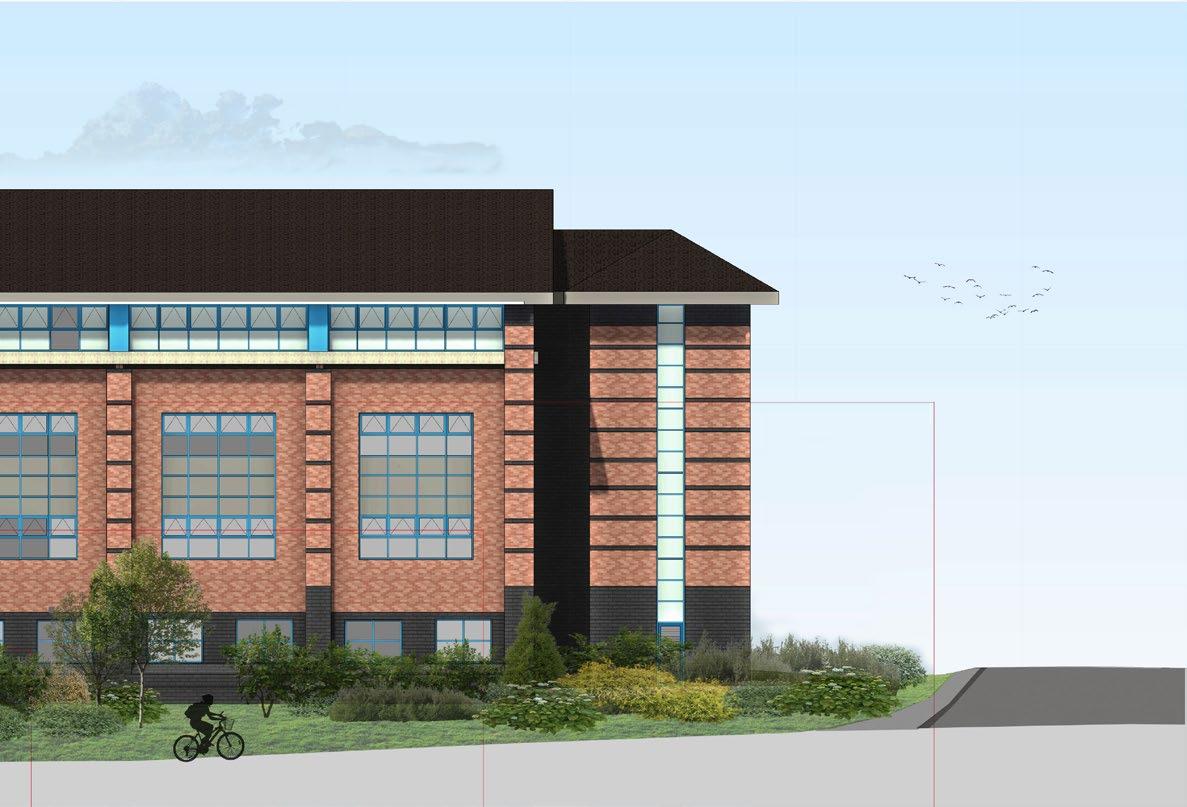
Dr Angus McGregor, Clinical Director of Pathology, said: “The addition of the CDC will offer our

patients more choice as to where to have their blood tests. Patients on arrival will have access to the excellent services already provided by our trained phlebotomists from The Princess Royal Hospital.”
The centre, which is sited at Hollinswood House in Stafford Park, will also house the renal dialysis service which is moving from the Princess Royal Hospital later this year.
It will enable teams to provide care for lower risk dialysis patients, with acute services remaining at the Royal Shrewsbury Hospital.
It will allow us to meet current demand, as well as provide clinical space to meet future demand over the next decade.
There is also free parking for patients and the centre will initially be open for five days a week from 9am until 5pm.
“The CDC aims to offer a one-stop service so if a patient requires more than one type of diagnostic investigation, the CDC will aim to provide them in one visit where possible to reduce multiple appointments, travelling and waiting times for diagnoses.”
Karla JenningsPreece, Project Lead and Operational Manager

OUR GETTING TO GOOD IMPROVEMENT JOURNEY Ambitious
Impact Magazine - Issue 10 13
CREATING A GREAT PLACE TO WORK
One of our ambitions is to be a compassionate and inclusive organisation that colleagues would recommend as a great place to work and receive care.
As part of our cultural improvement journey, we have been investing in developing great leaders and aspiring leaders.
We know from our recent staff survey results that effective leadership matters to you when it comes to improving our working environment. We also know that creating a happy, safe working culture can have a truly positive effect on patient experience and the quality of care we are able to provide. It improves teamwork, morale and of course, helps us to retain our brilliant colleagues.
That is why making our Trust a great place to work for everyone is one of our goals in our Trust Strategy over the coming years.
We have supported an improved leadership development offer to help us achieve this ambition.
Leadership can be challenging, but rewarding, so the aim is to fully equip our leaders with the right skills and confidence to support teams to grow and be the very best they can be. This includes supporting colleague wellbeing and development, handling difficult conversations and conflict, and effective decision making.
We are supporting our leaders to be compassionate and inclusive, which ultimately will support the culture change happening across the Trust.

John Skelton, Head of Leadership said: “We know from feedback in the staff survey that having strong and effective leadership is important to colleagues. That is why we are committed to supporting
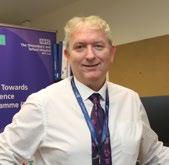
all our leaders and managers to successfully fulfil their roles, creating environments where teams can flourish.”
Our organisation has invested in new leadership programmes and development opportunities - on the intranet here - which are open to aspirational leaders, supervisory, first line, middle managers and senior managers.
Anecdotal feedback has shown that the programmes increase levels of patient satisfaction, quality of care, safety and assurance.
“A key goal in our Trust Strategy is to make SaTH a great place to work. We want all our colleagues to feel they are listened to and valued. Effective leadership has an important part to play in helping us to achieve this underpinned by our values.
“Investing in our leaders and developing our aspiring leaders of the future, means we have a rock solid structure in place to support, develop and grow our great teams.”
Rhia Boyode, Director of
 & OD
& OD
Ambitious OUR GETTING TO GOOD IMPROVEMENT JOURNEY
People
Impact Magazine - Issue 10 14
One of our leaders is Hayley Pearson, Deputy Chief Pharmacist.
Hayley recently took part in the “SaTH 4 Leadership” programme which provided the opportunity to develop her leadership skills and network with like-minded others. The programme is aimed at senior leaders who are seeking to improve their leadership abilities. It is run over four days and is interactive.
Hayley said: “I moved into a new role as deputy chief pharmacist and really wanted to make sure I was the best leader I could be to my amazing team. I specifically wanted support in navigating how to successfully manage a large department across two hospital sites and be visible.
“My job was a new role, so not only was I getting to grips with it myself, but I also wanted to make sure it was embedded successfully in the team and across the organisation.
“The programme provided tailored leadership support to me, and it has given me the skills to feel confident in my role and lead my team successfully.
“I have implemented very practical processes to ensure my team is supported with all members of the team receiving 1:1s, wellbeing checks, improved communication and regular spotlights on successes within the team.”
Since taking part on the programme, Hayley was offered a secondment as interim chief pharmacist and has also seen morale and productivity increase within her team.
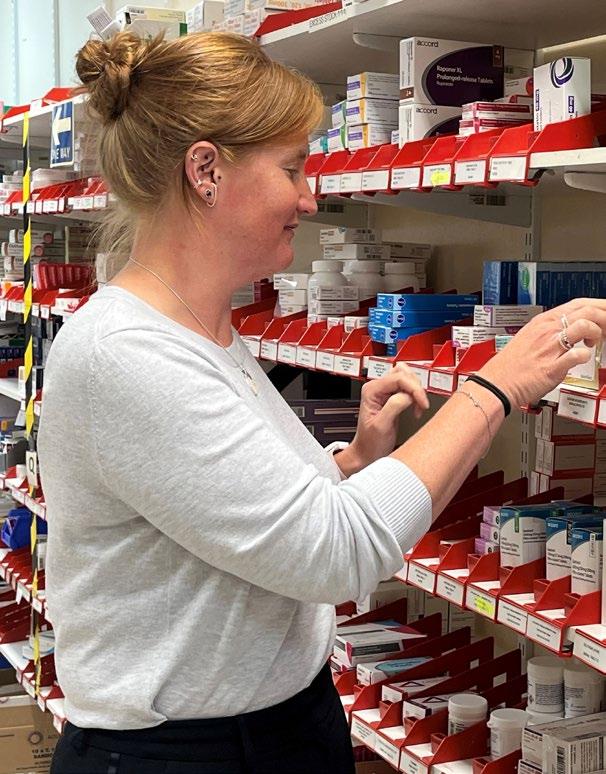
Did you know?
• We invest over £800,000 of funding in training and education to ensure that our workforce is available in the right numbers, with the right values, skills and behaviours to meet the needs of our patients now and in the future
• Over 160 colleagues have benefitted from our leadership programmes
• To date, thanks to the programmes, there have been 15 promotions and role changes
• We have also developed internal capacity to deliver the programmes, saving over £160,000
• We held our first leadership conference for some time, opened by Louise Barnett (pictured).
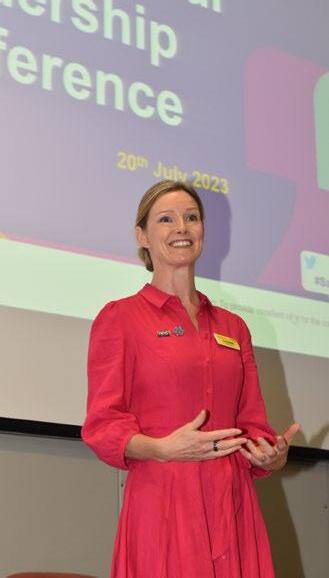
OUR GETTING TO GOOD IMPROVEMENT JOURNEY Ambitious
Impact Magazine - Issue 10 15
In our next edition we will be focusing on:
• Improving our cancer performance for our patients
• How our theatre teams are working together to grow and thrive
• Making the best use of every pound for our patients

• Next steps for our electronic patient record

G Partnering Ambitious Caring Trusted
Impact Magazine - Issue 10 16






























 & OD
& OD



